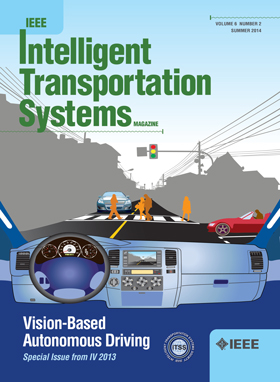学习驾驶员感知与控制的主动推理模型:在车辆跟车中的应用
IF 8.4
1区 工程技术
Q1 ENGINEERING, CIVIL
IEEE Transactions on Intelligent Transportation Systems
Pub Date : 2025-06-10
DOI:10.1109/TITS.2025.3574552
引用次数: 0
摘要
在本文中,我们介绍了一种通用的估计方法,用于在有限的演示集的基础上学习人类感知和控制的感觉运动控制任务模型。该模型的结构包括(i)代理对环境和相关观察结果如何作为控制行为的结果而演变的内部表示,以及(ii)代理对可观察结果的偏好。我们认为模型的结构规范与主动推理是一致的,主动推理是认知科学中关于人类感知和行为的理论。根据主动推理,智能体对世界采取行动,以最大限度地减少惊喜,惊喜被定义为智能体当前感官观察与其首选感官观察差异程度的度量。我们提出了一种双层优化估计方法,该方法依赖于先验分布的结构假设,该假设参数化了人类代理的环境模型的统计准确性。为了说明所提出的方法,我们提出了基于自然数据集的汽车跟随行为模型的估计。总的来说,研究结果表明,从数据中学习人类感知和控制的主动推理模型是一种有希望的替代封闭的驾驶模型。本文章由计算机程序翻译,如有差异,请以英文原文为准。
Learning an Active Inference Model of Driver Perception and Control: Application to Vehicle Car-Following
In this paper we introduce a general estimation methodology for learning a model of human perception and control in a sensorimotor control task based upon a finite set of demonstrations. The model’s structure consists of (i) the agent’s internal representation of how the environment and associated observations evolve as a result of control actions and (ii) the agent’s preferences over observable outcomes. We consider a model’s structure specification consistent with active inference, a theory of human perception and behavior from cognitive science. According to active inference, the agent acts upon the world so as to minimize surprise defined as a measure of the extent to which an agent’s current sensory observations differ from its preferred sensory observations. We propose a bi-level optimization approach to estimation which relies on a structural assumption on prior distributions that parameterize the statistical accuracy of the human agent’s model of the environment. To illustrate the proposed methodology, we present the estimation of a model for car-following behavior based upon a naturalistic dataset. Overall, the results indicate that learning active inference models of human perception and control from data is a promising alternative to closed-box models of driving.
求助全文
通过发布文献求助,成功后即可免费获取论文全文。
去求助
来源期刊

IEEE Transactions on Intelligent Transportation Systems
工程技术-工程:电子与电气
CiteScore
14.80
自引率
12.90%
发文量
1872
审稿时长
7.5 months
期刊介绍:
The theoretical, experimental and operational aspects of electrical and electronics engineering and information technologies as applied to Intelligent Transportation Systems (ITS). Intelligent Transportation Systems are defined as those systems utilizing synergistic technologies and systems engineering concepts to develop and improve transportation systems of all kinds. The scope of this interdisciplinary activity includes the promotion, consolidation and coordination of ITS technical activities among IEEE entities, and providing a focus for cooperative activities, both internally and externally.
 求助内容:
求助内容: 应助结果提醒方式:
应助结果提醒方式:


